From One Service to Many: The Evolution of Pricing in the Relocation Management Industry
From Revenue Ruling 72-339 in the 1970s to the NAR lawsuits of the 2020s, the relocation industry has undergone decades of evolution. Here, we break down the history of how the industry has adapted to the times.
The average cost of a U.S. domestic permanent transfer is $85,466 for homeowners and $33,532 for renters, and significantly in excess of that for international relocations, according to 2022 WERC data. Thus, approximately 88% of companies with significant global mobility programs outsource to a third-party relocation management company (RMC). Within these programs, the sale of an employee’s home is the most commonly outsourced element of the relocation function (90% of companies outsource home sales today).
Since its inception in 1962 when the first RMC was formed, the corporate relocation industry has undergone a series of evolutions in response to shifting economics, global events, and alignment to corporate client priorities. The industry we know today initially centered around home sale in the U.S. with a fee-for-service model, and from there naturally grew to include international mobility, additional relocation-related services, and partnerships with global supply chains. This growth introduced zero-fee programs.
As the role of the RMC expanded, cost-saving strategies for the corporate client sprung up to include referral fees, rebates, and partnership bonuses. This reflected the dynamic nature and complexity of corporate relocation management and adaptation to market and economic conditions.
Recent developments affecting the U.S. real estate industry point to the necessity for RMCs to once again adapt their business models to ensure compliance with recent legislation and reduce litigation exposure, as well as enhance revenue transparency for the client in a new age. For clients, this transformation could bring heightened predictability in their relocation spend. This whitepaper summarizes the global mobility industry’s evolution.
1970s | The Formalization of Home Sale Programs

In the early 1970s, the Internal Revenue Service (IRS) began looking closer at the common corporate practice of reimbursing a relocating employee for the closing costs of their home. The IRS felt this financial benefit was equivalent to a bonus and should be taxed as personal income for the employee.
Largely due to the increasing complexity of the departure home disposition, RMCs formed to provide guidance and facilitate home sale programs. To alleviate additional tax liability, companies (either the corporate or the RMC) created two separate sales of the property. The company purchased the property at either the agreed upon sales price with the “outside buyer” or the average appraised value, whichever was higher. Then the company sold the house to the “outside buyer,” paying all of the closing costs.
The founders of the industry worked with the U.S. government to structure a series of IRS revenue rulings to regulate corporate home sale programs and create tax protections.
1972, Revenue Ruling 72-339 officially set the tax code that regulates home sale programs to this day. Revenue Ruling 72-339 effectively guaranteed that an RMC could facilitate home sale programs more cost effectively than in-house corporate programs and led to the proliferation of the business model.
According to a 1976 survey by the Employee Relocation Council (WERC today), a third of corporations polled used an RMC, compared to 24% two years earlier. By 1978, around 700 corporations were using the services of an RMC.
1980s | Spotlight on Guaranteed Buyouts

While most corporates were still managing their mobility programs internally, the relocation management industry was beginning to grow. “Customer focus” became the new buzzword.
Less than a dozen RMCs existed in the 1980s and all predominantly offered guaranteed buyouts, known as GBO programs – including Altair Global. In a GBO, home sales were managed by a team of field coordinators and conducted on a fee-for-service basis. This was typically calculated as a percentage of the home’s appraised value. There were no fees for destination home purchases.
Newly enhanced information management systems made it easier to see the costs associated with relocation. Facing higher interest rates and relocation costs, some corporations established on-site relocation centers and/or encouraged relocating employees to use amended value (AV) programs.
In an AV sale, the employee would market the home once receiving the GBO offer to see if they could secure a higher price, and the RMC would “amend” the value to the higher sales price.
Example: GBO

Early 1990s | A Growing Menu of Services

The outsourcing of relocation services to an RMC steadily increased, driven by the administrative and cost efficiencies and superior service levels offered by these outside providers. Procurement departments stepped into the RMC selection process and broadened the scope of services requested. To better support their relocating employees through these life-changing transitions, additional services were added to include benefits to renters, household goods (HHG) shipments, spousal assistance, dual-career mortgage qualification, and expense processing.
For home sale, the buyer value option (BVO) was introduced and is still in use today. In a BVO, the relocating employee refers the outside offer to the RMC, who verifies that the contract represents a bona fide offer, without contingency, from a qualified buyer. The RMC then executes a contract with identical terms and net sales price with the employee.
Late 1990s | Hello, World
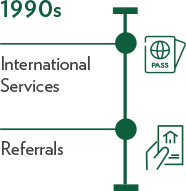
Corporate relocation management until this point was a U.S. domestic business, with a small number of zero-fee programs for large volume clients. Then in the final years of the 20th century, relocation management went international. The early days of international assignment support were as a fee-based service, as RMCs explored new markets to support their clients’ business and talent needs. With strong supply chain relationships in place, RMCs could offer further administration savings to clients through commissions and other referrals through new service lines.
Additional services added for international relocation support could include visa and immigration, cross-cultural training, language education, host housing, and school search. This also brought additional financial service requirements as it related to global compensation and global tax compliance.
As service offerings expanded, administration fees paid to the RMC were significantly reduced – often nearing $0 – for both homeowner and renter customers. RMCs began collecting referral revenue from their supply chain to offset their costs and charging a penalty to the client in the form of a referral recovery fee for not using the provided real estate services.
Early 2000s | Adoption of Low- or No-fee Programs
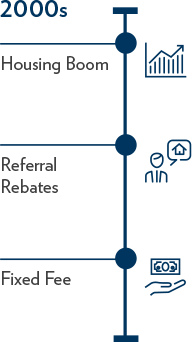
The aughts started poorly, first with the dot-com stock bubble burst in 2000 and then the 9/11 terrorist attacks in 2001. The economic aftershocks of these events stalled the real estate market. The Federal Reserve lowered interest rates to stimulate the economy, which led to record-low mortgage rates and easier access to credit, creating a housing boom which lasted until 2008 (more on that next).
The relocation management industry met these changing economic times with the adoption of fully outsourced low- to no-fee home sale programs. With this, RMCs also began offering referral fee rebates based on home sale volume and average values to the client to offset the cost of their overall mobility program spend. As real estate values soared, this allowed RMCs to begin sharing rebates with their clients.
The typical departure home sale referral share ranged from 15-25% depending on the program volume, percentage of home sale authorizations, and average values of the properties. It was not uncommon for the home sale percentage to run close to 70% of overall volume. This model also allowed for greatly reduced pricing for renter, intern, and lump sum populations.
Additionally, the industry began adopting fixed-fee home sale programs. In the past this had been done exclusively with government business, but in the early 2000s it began to be introduced to mainstream corporate programs. In a fixed-fee program, the RMC would guarantee to buy the home for a predetermined percentage of the property’s value. The RMC would then manage the risks associated with selling the home, often leading to positive revenue.
Example: Fixed Fee, Housing Boom

Late 2000s | Home Sale Hardship
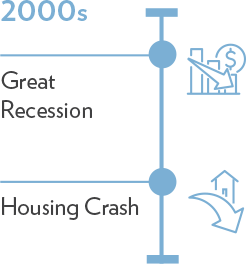
The crisis of the Great Recession in 2008 and 2009 affected national economies globally. The U.S. specifically saw the worst downturn since the Great Depression of the 1930s, with home prices falling roughly 30% and 6 million households losing their home. RMCs who had adopted a fixed-fee home sale model during the housing boom suffered.
Example: Fixed Fee, Housing Crash

Given the economic environment, the RMC’s ability to leverage discounts and cost savings from suppler partnerships, specifically household goods shipment and temporary living, eroded over time. Low-volume mobility programs were often receiving the same discount for RMC supplier passthrough costs as large-volume programs, which was not sustainable.
2010s | The Rise of Tech
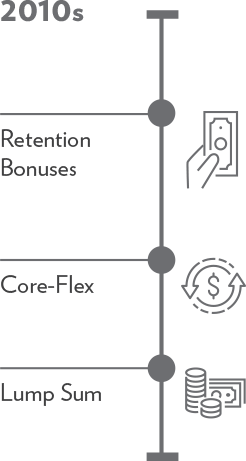
The real estate market was slow to recover from the 2008 downturn, and lower home prices impacted referrals and the bottom line for RMCs. To incentivize clients to extend their contracts, RMCs introduced partnership and retention bonus offerings to continue to support clients’ mobility teams and program delivery.
During this time, technological innovation and adoption skyrocketed. Apple launched WiFi-enabled iMessage and hands-free AirPods, Slack revolutionized company messaging, Uber and Lyft hit the streets, and Oculus virtual reality opened new frontiers – much powered by a breakthrough 4G network which allowed individuals to browse the web and stream HD video from their new smartphones. Tech-driven societal shifts ushered in a new era of how we live and do business – including how we approach and execute corporate relocations.
Mobile employees, now connected to the world like never before, sought greater flexibility and choice in their relocations. Driven by these shifting employee preferences as well as the cost of relocation overall, corporate mobility began to diversify into limited-service program offerings called core/flex. These programs offer relocating employees a set of fixed (or core) benefits to support the basic needs of their move, in addition to options to select supplement benefits best suited to their unique situation. While desirable for the customer, core/flex programs reduced the share of home sale benefits from 70% to around 10% for the RMC.
Lump sum programs also became popular in this decade, in which the corporation offered the employee cash to offset their own costs of a move in lieu of predetermined and fully managed relocation benefits. This further contributed to revenue erosion for the RMC.
2020s to Today | A Need for Change

In 2023, two landmark suits, Sitzer/Burnett v. NAR, et al (filed in Missouri) and Moerhl v. NAR, et al (filed in Illinois), were brought against the National Associations of REALTORS (NAR) and a collection of real estate brokerages that positively affect home purchasers in the U.S. – especially first-time homebuyers. (Learn more in our latest whitepaper on the topic, here.) There are several business practices included in the settlement that impact how real estate transactions occur, namely:
- Decoupling of commissions.
- Removal from and prohibited disclosure of broker compensation on the multiple listing service (MLS).
- Mandated usage of the buyer representation agreement.
The settlement of these lawsuits, effective in 2024, will alter employer-facilitated relocations and mobility programs. As such, the RMC model once again needs to evolve with the times.
Share This Story, Choose Your Platform!
From Revenue Ruling 72-339 in the 1970s to the NAR lawsuits of the 2020s, the relocation industry has undergone decades of evolution. Here, we break down the history of how the industry has adapted to the times.
The average cost of a U.S. domestic permanent transfer is $85,466 for homeowners and $33,532 for renters, and significantly in excess of that for international relocations, according to 2022 WERC data. Thus, approximately 88% of companies with significant global mobility programs outsource to a third-party relocation management company (RMC). Within these programs, the sale of an employee’s home is the most commonly outsourced element of the relocation function (90% of companies outsource home sales today).
Since its inception in 1962 when the first RMC was formed, the corporate relocation industry has undergone a series of evolutions in response to shifting economics, global events, and alignment to corporate client priorities. The industry we know today initially centered around home sale in the U.S. with a fee-for-service model, and from there naturally grew to include international mobility, additional relocation-related services, and partnerships with global supply chains. This growth introduced zero-fee programs.
As the role of the RMC expanded, cost-saving strategies for the corporate client sprung up to include referral fees, rebates, and partnership bonuses. This reflected the dynamic nature and complexity of corporate relocation management and adaptation to market and economic conditions.
Recent developments affecting the U.S. real estate industry point to the necessity for RMCs to once again adapt their business models to ensure compliance with recent legislation and reduce litigation exposure, as well as enhance revenue transparency for the client in a new age. For clients, this transformation could bring heightened predictability in their relocation spend. This whitepaper summarizes the global mobility industry’s evolution.
1970s | The Formalization of Home Sale Programs

In the early 1970s, the Internal Revenue Service (IRS) began looking closer at the common corporate practice of reimbursing a relocating employee for the closing costs of their home. The IRS felt this financial benefit was equivalent to a bonus and should be taxed as personal income for the employee.
Largely due to the increasing complexity of the departure home disposition, RMCs formed to provide guidance and facilitate home sale programs. To alleviate additional tax liability, companies (either the corporate or the RMC) created two separate sales of the property. The company purchased the property at either the agreed upon sales price with the “outside buyer” or the average appraised value, whichever was higher. Then the company sold the house to the “outside buyer,” paying all of the closing costs.
The founders of the industry worked with the U.S. government to structure a series of IRS revenue rulings to regulate corporate home sale programs and create tax protections.
1972, Revenue Ruling 72-339 officially set the tax code that regulates home sale programs to this day. Revenue Ruling 72-339 effectively guaranteed that an RMC could facilitate home sale programs more cost effectively than in-house corporate programs and led to the proliferation of the business model.
According to a 1976 survey by the Employee Relocation Council (WERC today), a third of corporations polled used an RMC, compared to 24% two years earlier. By 1978, around 700 corporations were using the services of an RMC.
1980s | Spotlight on Guaranteed Buyouts

While most corporates were still managing their mobility programs internally, the relocation management industry was beginning to grow. “Customer focus” became the new buzzword.
Less than a dozen RMCs existed in the 1980s and all predominantly offered guaranteed buyouts, known as GBO programs – including Altair Global. In a GBO, home sales were managed by a team of field coordinators and conducted on a fee-for-service basis. This was typically calculated as a percentage of the home’s appraised value. There were no fees for destination home purchases.
Newly enhanced information management systems made it easier to see the costs associated with relocation. Facing higher interest rates and relocation costs, some corporations established on-site relocation centers and/or encouraged relocating employees to use amended value (AV) programs.
In an AV sale, the employee would market the home once receiving the GBO offer to see if they could secure a higher price, and the RMC would “amend” the value to the higher sales price.
Example: GBO

Early 1990s | A Growing Menu of Services

The outsourcing of relocation services to an RMC steadily increased, driven by the administrative and cost efficiencies and superior service levels offered by these outside providers. Procurement departments stepped into the RMC selection process and broadened the scope of services requested. To better support their relocating employees through these life-changing transitions, additional services were added to include benefits to renters, household goods (HHG) shipments, spousal assistance, dual-career mortgage qualification, and expense processing.
For home sale, the buyer value option (BVO) was introduced and is still in use today. In a BVO, the relocating employee refers the outside offer to the RMC, who verifies that the contract represents a bona fide offer, without contingency, from a qualified buyer. The RMC then executes a contract with identical terms and net sales price with the employee.
Late 1990s | Hello, World

Corporate relocation management until this point was a U.S. domestic business, with a small number of zero-fee programs for large volume clients. Then in the final years of the 20th century, relocation management went international. The early days of international assignment support were as a fee-based service, as RMCs explored new markets to support their clients’ business and talent needs. With strong supply chain relationships in place, RMCs could offer further administration savings to clients through commissions and other referrals through new service lines.
Additional services added for international relocation support could include visa and immigration, cross-cultural training, language education, host housing, and school search. This also brought additional financial service requirements as it related to global compensation and global tax compliance.
As service offerings expanded, administration fees paid to the RMC were significantly reduced – often nearing $0 – for both homeowner and renter customers. RMCs began collecting referral revenue from their supply chain to offset their costs and charging a penalty to the client in the form of a referral recovery fee for not using the provided real estate services.
Early 2000s | Adoption of Low- or No-fee Programs

The aughts started poorly, first with the dot-com stock bubble burst in 2000 and then the 9/11 terrorist attacks in 2001. The economic aftershocks of these events stalled the real estate market. The Federal Reserve lowered interest rates to stimulate the economy, which led to record-low mortgage rates and easier access to credit, creating a housing boom which lasted until 2008 (more on that next).
The relocation management industry met these changing economic times with the adoption of fully outsourced low- to no-fee home sale programs. With this, RMCs also began offering referral fee rebates based on home sale volume and average values to the client to offset the cost of their overall mobility program spend. As real estate values soared, this allowed RMCs to begin sharing rebates with their clients.
The typical departure home sale referral share ranged from 15-25% depending on the program volume, percentage of home sale authorizations, and average values of the properties. It was not uncommon for the home sale percentage to run close to 70% of overall volume. This model also allowed for greatly reduced pricing for renter, intern, and lump sum populations.
Additionally, the industry began adopting fixed-fee home sale programs. In the past this had been done exclusively with government business, but in the early 2000s it began to be introduced to mainstream corporate programs. In a fixed-fee program, the RMC would guarantee to buy the home for a predetermined percentage of the property’s value. The RMC would then manage the risks associated with selling the home, often leading to positive revenue.
Example: Fixed Fee, Housing Boom

Late 2000s | Home Sale Hardship

The crisis of the Great Recession in 2008 and 2009 affected national economies globally. The U.S. specifically saw the worst downturn since the Great Depression of the 1930s, with home prices falling roughly 30% and 6 million households losing their home. RMCs who had adopted a fixed-fee home sale model during the housing boom suffered.
Example: Fixed Fee, Housing Crash

Given the economic environment, the RMC’s ability to leverage discounts and cost savings from suppler partnerships, specifically household goods shipment and temporary living, eroded over time. Low-volume mobility programs were often receiving the same discount for RMC supplier passthrough costs as large-volume programs, which was not sustainable.
2010s | The Rise of Tech

The real estate market was slow to recover from the 2008 downturn, and lower home prices impacted referrals and the bottom line for RMCs. To incentivize clients to extend their contracts, RMCs introduced partnership and retention bonus offerings to continue to support clients’ mobility teams and program delivery.
During this time, technological innovation and adoption skyrocketed. Apple launched WiFi-enabled iMessage and hands-free AirPods, Slack revolutionized company messaging, Uber and Lyft hit the streets, and Oculus virtual reality opened new frontiers – much powered by a breakthrough 4G network which allowed individuals to browse the web and stream HD video from their new smartphones. Tech-driven societal shifts ushered in a new era of how we live and do business – including how we approach and execute corporate relocations.
Mobile employees, now connected to the world like never before, sought greater flexibility and choice in their relocations. Driven by these shifting employee preferences as well as the cost of relocation overall, corporate mobility began to diversify into limited-service program offerings called core/flex. These programs offer relocating employees a set of fixed (or core) benefits to support the basic needs of their move, in addition to options to select supplement benefits best suited to their unique situation. While desirable for the customer, core/flex programs reduced the share of home sale benefits from 70% to around 10% for the RMC.
Lump sum programs also became popular in this decade, in which the corporation offered the employee cash to offset their own costs of a move in lieu of predetermined and fully managed relocation benefits. This further contributed to revenue erosion for the RMC.
2020s to Today | A Need for Change

In 2023, two landmark suits, Sitzer/Burnett v. NAR, et al (filed in Missouri) and Moerhl v. NAR, et al (filed in Illinois), were brought against the National Associations of REALTORS (NAR) and a collection of real estate brokerages that positively affect home purchasers in the U.S. – especially first-time homebuyers. (Learn more in our latest whitepaper on the topic, here.) There are several business practices included in the settlement that impact how real estate transactions occur, namely:
- Decoupling of commissions.
- Removal from and prohibited disclosure of broker compensation on the multiple listing service (MLS).
- Mandated usage of the buyer representation agreement.
The settlement of these lawsuits, effective in 2024, will alter employer-facilitated relocations and mobility programs. As such, the RMC model once again needs to evolve with the times.


![From One Service to Many: The Evolution of Pricing in the Relocation Management Industry 6 [GUIDE] Local Plus Policy Considerations](https://www.altairglobal.com/wp-content/uploads/2024/12/GCS-Thought-Leadership-Blog-Header-Image-500x383.png)



